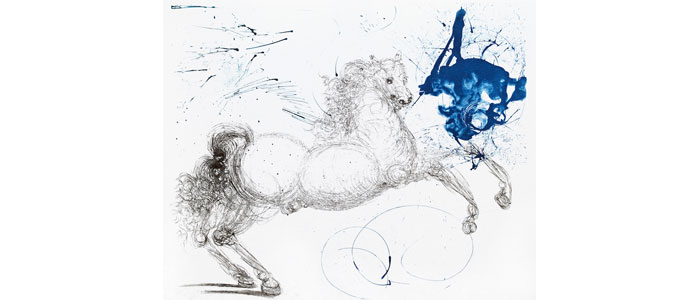Park Record: Christine Argillet enjoys spreading the surrealist joy of Salvador Dali
Reprinted from Park Record
Many people are familiar with the dreamlike paintings of Spanish surreal artist Salvador Dali.
His best-known work, “Persistence of Memory,” depicts melted clocks hanging limply off different objects.
Park City art lovers will have the chance to see and purchase another side of the late artist’s works when Madame Christine Argillet, daughter of Salvador Dali’s publisher Pierre Argillet, will appear at the Old Towne Gallery, 580 Main St., this weekend.
Argillet will be at the gallery from 11 a.m. to 1 p.m. and 7-9 p.m. on Saturday, March 18; and from 1-3 p.m. on Sunday, March 19.
She will give personal tours of Salvador Dali’s “The Argillet Collection” that includes an array of works Dali gave to her father, who passed away in 2001.
“We will be showing 85 pieces and our collection mostly consists of copper etchings that were done between 1934 and 1973, nothing later,” Argillet said during a phone call to The Park Record from her home in Los Angeles. “We have also a few drawings and watercolors that were projects for the etchings, and we have also a few aubusson tapestries that were hand-woven in 1973 to 1975.”
Argillet is looking forward to the Park City show.
“I am pleased to come to Park City for the first time, because my father would always tell me not to show these works in Paris or London,” she said. “He wanted us to show these works in places where they are unexpected.
“So, I decided when my father passed away to show this collection as much as possible,” Argillet said. “I wanted to show it not only in galleries, but also in museums.”
Each piece shows differences in Dali’s characteristics that may surprise many.
“Most of the people know his paintings, but the works in this exhibit show some [etching] techniques that are more traditional in a way that people like Rembrandt or Picasso worked with at different times,” Argillet said. “It’s an interesting technique because the artist works with a stylus [to mark] the copper plate. It’s a sensitive technique, because no line can be canceled once you draw the line. This method reveals the skill, the intention, movement, spontaneity and control of the artist.”
The works will also show Dali’s evolution as an artist.
The works in Dali’s “Greek Mythology” series from the early 1960s shows how the artist was still very controlled in his methods.
“Dali would [meticulously] go over the details and the art is very close to these myths,” Argillet said. “Then in the mid-1960s, you see a shift. Dali became more spontaneous and he created work faster. There is something fresh and rapid in these works etchings.”
Some of these etchings, such as the works depicting Diane de Poitiers, were never finished.
“Diane de Poitiers was a beautiful French mistress of a king, and she was known for having very long hair and a very long veil during the time of the Renaissance,” Argillet said. “Dali drew with one line the design of her entire body. And when he came to draw her foot, he didn’t draw a foot, but rather a flower. It is absolutely charming.”
Other works in the collection show Dali’s wry sense of humor, something that may surprise a handful of collectors.
“You see that in his ‘Bullfight’ series, where he took the Picasso bullfight paintings and, quote, ‘Dali-ized’ them in his etchings,” Argillet said with a laugh.
These paintings show how much Dali hated bullfights, because he found them barbaric.
“He was shocked the priests and archbishops would bless the scene before the game would start,” Argillet said. “He was shocked at how the people wanted to see blood and request the death of the bull.”
Making a humorous and social statement, Dali depicted himself as the bull in these works.
“He elegantly did this by drawing his mustache and long eye lashes, which is the sign of himself, on the bull,” Argillet said. “Then you would see the people on the steps and stands with horns, that show that they are more barbaric than the bull. It was his elegant and humorous way to show the ridicule of the situation.”
Argillet enjoys showing the exhibit to younger people, because Dali’s rebellious spirit connects with them.
“He had this extraordinary skill to go from [one] technique to the other and grab one idea and bring it to the other,” she said. “He had that flexibility in his mind and I think that is very close to the young people today.”
Argillet confessed with a laugh that she doesn’t have a favorite piece in the exhibit.
“It’s because I’m very unfaithful,” she giggled.
The reason for the artistic infidelity is life.
“People who enjoy art have their eyes touched by something that follows their own quest or whatever we could call it,” Argillet said. “With the years, I have rediscovered this collection that I have known very well through the passing of time.
“I have learned to see it in a different way and each time I have a show, sometimes people will ask my why Dali did this or that, and suddenly, I will rediscover the art and that will change my mind.
“The beauty of art is that you never end your self-reflection with what you see,” she said. “Right now I enjoy the Bullfight works, but I know I’ll be attracted to another work in five years.”
Madame Christine Argillet, daughter of Salvador Dali’s publisher Pierre Argillet, will be at the Old Towne Gallery, 580 Main St., from 11 a.m. to 1 p.m. and 7-9 p.m. on Saturday, March 18; and from 1-3 p.m. on Sunday, March 1. RSVPs are required. They can be made by calling 435-655-3910 or by emailing info@oldtownegallery.com. For information, visit http://www.oldtownegallery.com.


Comments are closed.